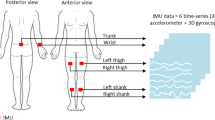Abstract
A vast population of visually impaired individuals is currently facing intricate life challenges, particularly related to perceiving walking directions. Therefore, this paper proposes a novel deep learning method based on wearable sensors to address the problem of walking direction recognition. The information mining and fusion module, the multi-feature position information mining attention module, and the multi-feature content information mining attention module are proposed to comprehensively mine comprehensive information from walking data. To overcome the limitation of information gathered from a single type of sensor, this paper combines inertial sensors and pressure insoles for walking direction recognition. Experimental results demonstrate that compared to existing research methods, the proposed method in this paper achieves a higher recognition accuracy highlighting the superiority and effectiveness of this method.





Similar content being viewed by others
Data Availability
Data will be made available on request.
References
Kuriakose, B., Shrestha, R., Sandnes, F.E.: Tools and technologies for blind and visually impaired navigation support: a review. IETE Tech. Rev. 39(1), 3–18 (2022)
Nithyakani, P., Ferni Ukrit, M.: Deep multi-convolutional stacked capsule network fostered human gait recognition from enhanced gait energy image. Signal Image Video Process. 18(2), 1375–1382 (2024)
Lee, E., Park, K.M., Lee, B.H., Kim, S.C., Choi, J.: CNN-based real-time walking direction estimation for pedestrian navigation scenarios. IEEE Sens. J. (2023). https://doi.org/10.1109/JSEN.2023.3333331
Elharrouss, O., Almaadeed, N., Al-Maadeed, S., Bouridane, A.: Gait recognition for person re-identification. J. Supercomput. 77, 3653–3672 (2021)
Das, S., Meher, S., Sahoo, U.K.: A unified local–global feature extraction network for human gait recognition using smartphone sensors. Sensors 22(11), 3968 (2022)
Zhang, M., Liu, D., Wang, Q., Zhao, B., Bai, O., Sun, J.: Gait pattern recognition based on plantar pressure signals and acceleration signals. IEEE Trans. Instrum. Meas. 71, 1–15 (2022)
Rifaat, N., Ghosh, U.K., Sayeed, A.: Accurate gait recognition with inertial sensors using a new FCN-BiLSTM architecture. Comput. Electr. Eng. 104, 108428 (2022)
Bondugula, R.K., Udgata, S.K., Sivangi, K.B.: A novel deep learning architecture and MINIROCKET feature extraction method for human activity recognition using ECG, PPG and inertial sensor dataset. Appl. Intell. 53(11), 14400–14425 (2023)
Gagliardi, G., Alfeo, A.L., Catrambone, V., Candia-Rivera, D., Cimino, M.G., Valenza, G.: Improving emotion recognition systems by exploiting the spatial information of EEG sensors. IEEE Access 11, 39544–39554 (2023)
Ahmed, K., Saini, M.: Fcml-gait: fog computing and machine learning inspired human identity and gender recognition using gait sequences. Signal Image Video Process. 17(4), 925–936 (2023)
Cao, Y., Zhou, Z., Zhu, C., Duan, P., Chen, X., Li, J.: A lightweight deep learning algorithm for wifi-based identity recognition. IEEE Internet Things J. 8(24), 17449–17459 (2021)
Ali, H.A.H., Seytnazarov, S.: Human walking direction detection using wireless signals, machine and deep learning algorithms. Sensors 23(24), 9726 (2023)
Yang, Yu., Carl, O., Hussain, S., Hou, W., Weis, T.: A privacy-protecting step-level walking direction detection algorithm based on floor vibration. IEEE Sens. J. 23(10), 10814–10824 (2022)
Yang, X., Yang, W., Chen, M., Chen, S., Huang, L.: Attention-based gait recognition and walking direction estimation in wi-fi networks. IEEE Trans. Mobile Comput. 21(2), 465–479 (2020)
Li, J., Wang, D., Liu, X., Shi, Z., Wang, M.: Two-branch attention network via efficient semantic coupling for one-shot learning. IEEE Trans. Image Process. 31, 341–351 (2021)
Janidarmian, M., Roshan Fekr, A., Radecka, K., Zilic, Z.: A comprehensive analysis on wearable acceleration sensors in human activity recognition. Sensors 17(3), 529 (2017)
Kang, J., Kim, J., Lee, S., Sohn, M.: Transition activity recognition using fuzzy logic and overlapped sliding window-based convolutional neural networks. J. Supercomput. 76(10), 8003–8020 (2020)
Woo, S., Park, J., Lee, J.-Y., Kweon, I.S.: Cbam: convolutional block attention module. In Proceedings of the European conference on computer vision (ECCV), pp. 3–19 (2018)
Shin, H.C., Roth, H.R., Gao, M., Lu, L., Xu, Z., Nogues, I., Summers, R.M.: Deep convolutional neural networks for computer-aided detection: CNN architectures, dataset characteristics and transfer learning. IEEE Trans. Med. Imag. 35(5), 1285–1298 (2016)
Xia, Z., Ding, G., Wang, H., Feng, X.: Person identification with millimeter-wave radar in realistic smart home scenarios. IEEE Geosci. Remote Sens. Lett. 19, 1–5 (2021)
Ahmad, Z., Khan, N.: Cnn-based multistage gated average fusion (mgaf) for human action recognition using depth and inertial sensors. IEEE Sens. J. 21(3), 3623–3634 (2020)
Huang, H., Zhou, P., Li, Y., Sun, F.: A lightweight attention-based cnn model for efficient gait recognition with wearable imu sensors. Sensors 21(8), 2866 (2021)
Shen, S., Sun, S.-S., Li, W.-J., Wang, R.-C., Sun, P., Wang, S., Geng, X.-Y.: A classifier based on multiple feature extraction blocks for gait authentication using smartphone sensors. Comput. Electr. Eng. 108, 108663 (2023)
Funding
This work was supported by National Natural Science Foundation of China under (Grant Nos., 61903170, 62173175, 61877033), and by the Natural Science Foundation of Shandong Province under grants Nos. ZR2019BF045, ZR2019MF021, ZR2019QF004, and by the Key Research and Development Project of Shandong Province of China, No.2019GGX101003.
Author information
Authors and Affiliations
Corresponding authors
Ethics declarations
Conflict of interest
The authors declare no Conflict of interest.
Ethical approval
Written informed consent was obtained from all the participants prior to the enrollment (or for the publication) of this paper.
Additional information
Publisher's Note
Springer Nature remains neutral with regard to jurisdictional claims in published maps and institutional affiliations.
Rights and permissions
Springer Nature or its licensor (e.g. a society or other partner) holds exclusive rights to this article under a publishing agreement with the author(s) or other rightsholder(s); author self-archiving of the accepted manuscript version of this article is solely governed by the terms of such publishing agreement and applicable law.
About this article
Cite this article
Guo, M., Qin, L., Yan, M. et al. Walking direction recognition based on deep learning with inertial sensors and pressure insoles. SIViP 19, 189 (2025). https://doi.org/10.1007/s11760-024-03753-6
Received:
Revised:
Accepted:
Published:
DOI: https://doi.org/10.1007/s11760-024-03753-6




